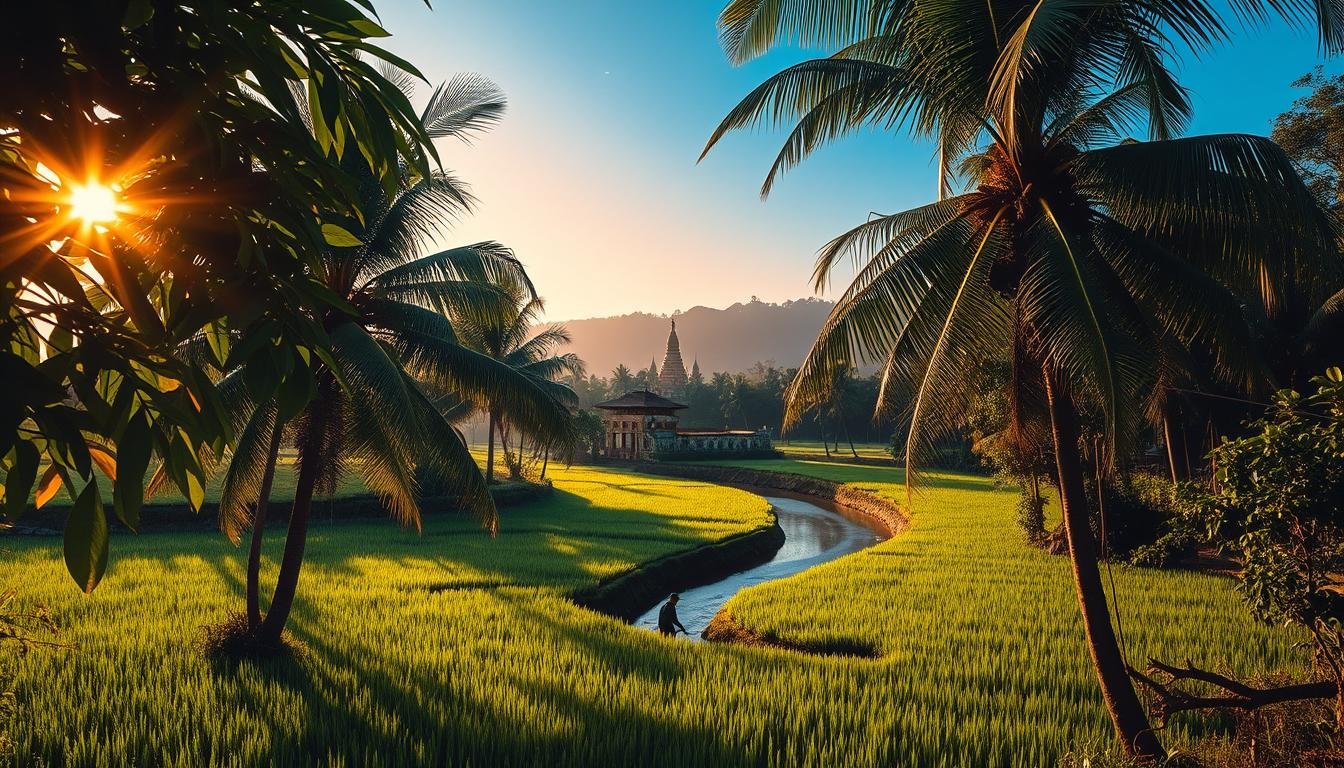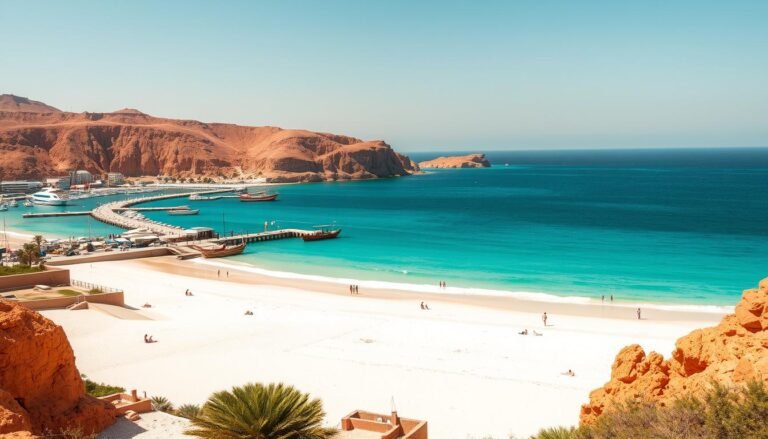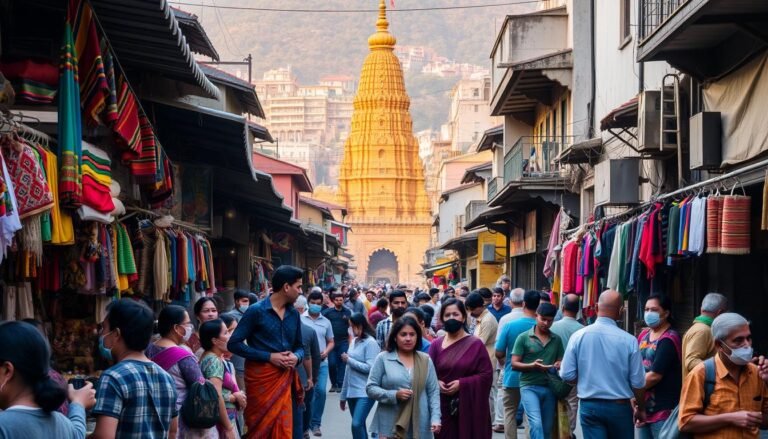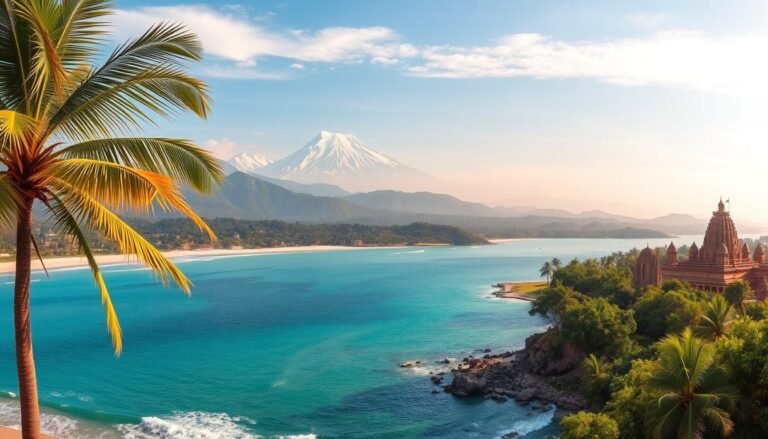The Perfect Time to Experience Bali
Time of bali Planning a trip to Bali requires understanding the optimal time to make the most of your experience.
The island’s unique position in the Indonesian archipelago creates distinct seasonal patterns that affect travel experiences. Understanding the Time of Bali is crucial for planning activities and maximizing your vacation days.
This comprehensive guide will help you determine when to visit based on weather, crowds, cultural events, and personal preferences. Whether you’re seeking sunny beach days or cultural immersion, knowing the best time to visit specific attractions can significantly enhance your travel experience.
Understanding Bali’s Time Zone
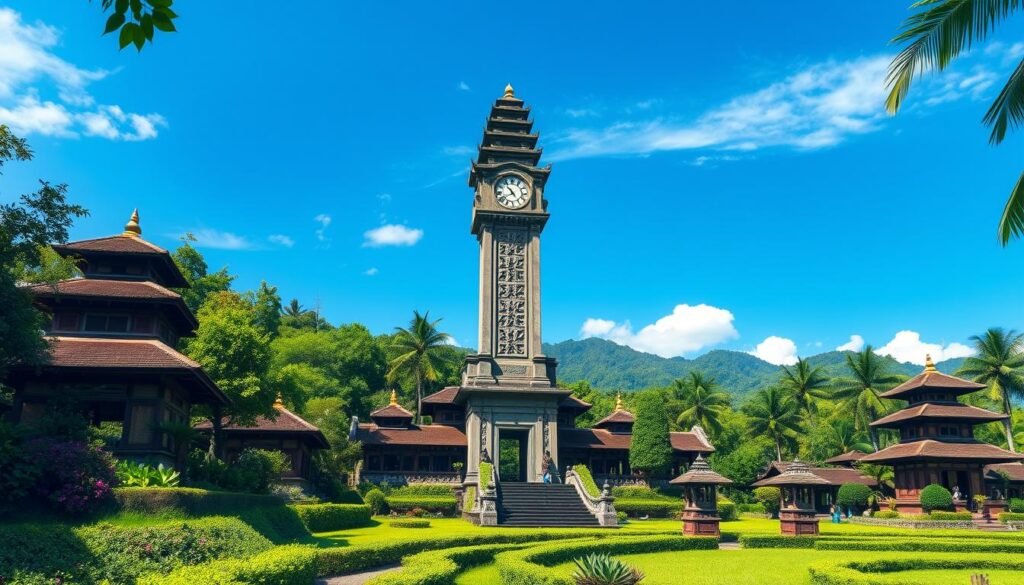
Bali operates on WITA (Waktu Indonesia Tengah), or Indonesia Central Time, which is UTC+8. This time zone is consistent throughout the year, making it 8 hours ahead of Coordinated Universal Time.
- Bali operates on Indonesia Central Time (WITA).
- The island maintains a consistent UTC+8 time zone.
- Understanding Bali’s time zone is essential for planning international calls and managing jet lag.
- Bali is one hour ahead of Jakarta, which operates on Western Indonesian Time (WIB).
- All locations within Bali share the same time zone.
- Factor in the hours needed to adjust to the time difference when planning your trip.
- Bali shares the same time zone as Singapore, Kuala Lumpur, and Perth.
Knowing that Bali is on WITA helps travelers coordinate activities and adjust to the local time, making their trip more enjoyable and stress-free, saving valuable hours.
The Time of Bali: WITA Explained
WITA, or Waktu Indonesia Tengah, is the official time standard in Bali, aligning with major Asian cities. This time zone is crucial for travelers to understand to coordinate their activities effectively.
Bali operates on Central Indonesian Time, which is UTC/GMT +8 hours. This places Bali 8 hours ahead of Greenwich Mean Time, making it significantly ahead of European and American time zones.
Understanding WITA helps travelers plan their day, including coordinating with local businesses, tour operators, and transportation schedules. Bali shares the same time zone with cities like Singapore, Kuala Lumpur, and Perth, making it convenient for regional travelers.
- WITA is the standard time zone used in Bali, ensuring consistency throughout the island.
- Local businesses operate on WITA, typically opening around 9:00 AM and closing by 9:00 PM.
- The consistent time zone makes it easier for visitors to plan activities without worrying about time changes.
When planning calls or virtual meetings with people back home, it’s essential to remember that Bali is significantly ahead of European and American time zones. This knowledge helps in avoiding scheduling conflicts.
No Daylight Saving Time in Bali
Unlike many countries, Bali does not observe daylight saving time, making it a hassle-free destination for travelers.
Bali’s consistent time zone, known as WITA, simplifies travel planning. The absence of daylight saving time means that the island’s sunrise and sunset times shift gradually with the seasons, rather than abruptly with clock changes.
- The consistent time zone helps maintain regular sleeping patterns and reduces confusion for international visitors.
- Indonesia’s equatorial position means daylight hours remain relatively consistent throughout the year, eliminating the need for saving daylight through time adjustments.
- For travelers coming from countries that do observe daylight saving, the time difference between their home and Bali will change when their home country adjusts its clocks.
Time Difference Considerations
| Country | Daylight Saving Time | Time Difference with Bali |
|---|---|---|
| UK | Yes | Variable |
| US | Yes (some states) | Variable |
| Australia | Yes (some states) | Variable |
When planning your trip, check whether your home country will be observing daylight saving time during your travel dates to accurately calculate the time difference.
Time Difference Between Bali and Major Cities
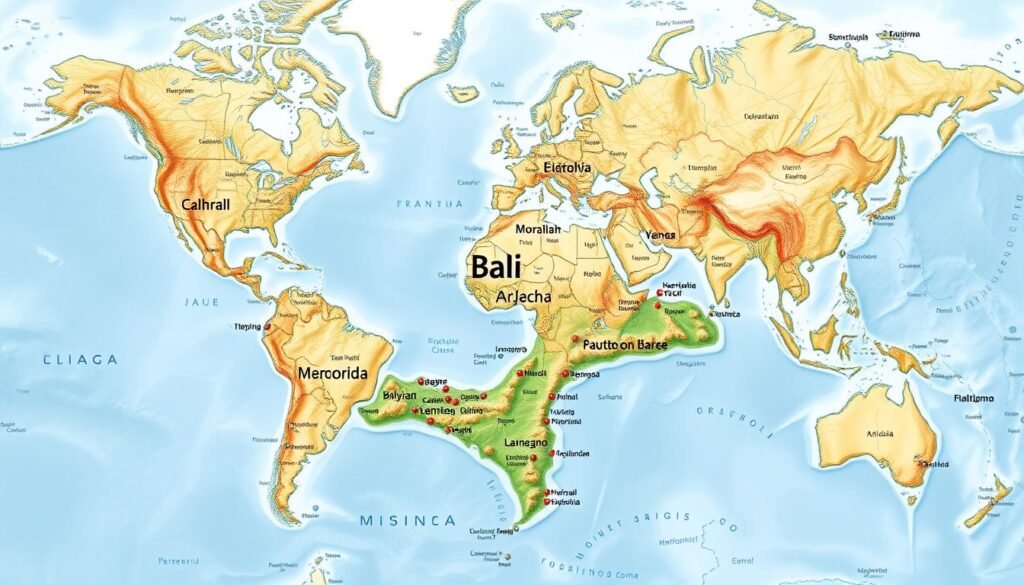
When planning a trip to Bali, it’s essential to consider the time difference between Bali and your hometown. This knowledge helps in scheduling flights, arranging meetings, and planning daily activities.
Bali vs. UK Time
The time difference between Bali and London is substantial. Bali is typically 7 hours ahead of London during standard time and 8 hours ahead during daylight saving time.
Bali vs. US Time
The time difference between Bali and the United States varies depending on the US city. For instance:
- The time difference between Bali and New York is around 11-12 hours, with Bali being ahead.
- Los Angeles and San Francisco are 14-15 hours behind Bali.
- Chicago is 12-13 hours behind Bali.
American travelers typically need 3-5 days to adjust to Bali’s time due to the significant time difference.
To manage the time difference effectively, consider scheduling calls with people back in the US during Bali mornings, which corresponds to evening hours in the US. This strategy can also be leveraged for work communications before US colleagues begin their workday.
Breaking up long-haul flights with a stopover can help your body adjust gradually to the time change, making your travel to Bali more comfortable.
Sunrise and Sunset in Bali
Bali’s proximity to the equator ensures relatively consistent daylight hours throughout the year. This consistency is a significant advantage for tourists planning their daily activities.
The sunrise in Bali typically occurs between 5:45 AM and 6:30 AM, while the sunset happens between 6:00 PM and 6:30 PM. This results in approximately 12 hours of daylight year-round, with minimal seasonal variation.
Sunrise and Sunset Times
| Event | Time | Direction |
|---|---|---|
| Sunrise | 6:29 am | ↑67° East |
| Sunset | 6:07 pm | ↑293° Northwest |
The consistent daylight pattern makes it easier for visitors to plan their outdoor activities. The golden hour, shortly after sunrise and before sunset, offers spectacular lighting conditions for photography at Bali’s scenic locations.
Early morning sunrise viewing is particularly popular at locations like Mount Batur, where hiking tours typically begin around 3:30 AM to reach the summit before dawn. Evening activities like beach dinners and cultural performances are timed around the consistent 6:00-6:30 PM sunset time throughout the year.
Understanding the precise sunrise and sunset times helps maximize your daily activities and capture the best lighting for photography. With approximately 11 hours and 38 minutes of daylight, visitors can make the most of their time in Bali.
Best Season to Visit Bali
Travelers to Bali can expect a diverse range of experiences based on the time of year they choose to visit. The island’s climate is generally warm, but there are two distinct seasons that can greatly impact your trip.

The dry season and wet season each have their unique charms and advantages.
Dry Season: May to September
The dry season is considered the peak tourist season in Bali, with dry and sunny weather prevailing from May to September. Temperatures are pleasant, making it ideal for outdoor activities.
Wet Season: October to April
The wet season brings regular rainfall, typically in the form of afternoon downpours, transforming Bali into a lush paradise. Despite the rain, temperatures remain warm, ranging from 75-90°F (24-32°C), with higher humidity.
- The wet season from October to April brings regular rainfall, typically in the form of afternoon downpours.
- Many travelers enjoy saving significantly on accommodations during this period, with prices often 30-50% lower than peak season.
- The rain patterns are generally predictable, with mornings typically clear and showers arriving in the afternoon or evening.
- This season is ideal for cultural activities, spa treatments, cooking classes, and other indoor experiences.
Weather Patterns Throughout the Year
Bali’s weather is characterized by a relatively predictable pattern throughout the year. The temperature variations are less dramatic than rainfall changes.
The island experiences consistently warm temperatures year-round, typically ranging from 75-90°F (24-32°C). Humidity levels fluctuate significantly, from around 60-70% during the dry season to 80-90% during the wet season.
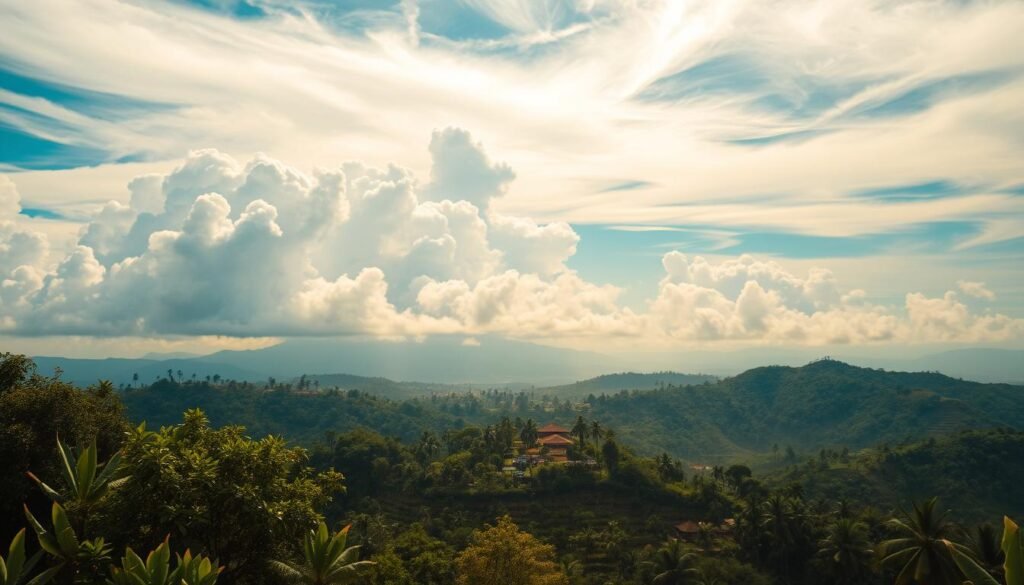
Rain patterns vary by month, with December through February experiencing the heaviest rainfall, often for several hours each day. April and October are transitional months with unpredictable weather, sometimes offering perfect conditions and other times bringing unexpected rain.
- The southern coastal areas like Kuta, Seminyak, and Nusa Dua typically receive less rainfall than the central mountainous regions around Ubud.
- Wind patterns affect water conditions, with the dry season generally offering calmer seas for swimming and water sports.
- Microclimates exist across the island, with the northern coast often experiencing different weather than the south on the same day.
Understanding these weather patterns can help you plan your trip to Bali, ensuring that you make the most of your time on the island. For instance, knowing that the dry season offers calmer seas can be crucial if you plan to spend several hours engaging in water activities.
Bali’s Cultural Calendar
Bali’s cultural scene is a kaleidoscope of festivals and traditions that are worth experiencing. The island celebrates various holidays and festivals throughout the year, reflecting its rich cultural heritage.

Important Holidays and Festivals
Bali observes numerous significant cultural and religious celebrations. Some of the key events include:
- Nyepi (Balinese New Year): Features ogoh-ogoh parades followed by a day of silence.
- Galungan: Celebrates the victory of dharma over adharma with elaborate decorations.
- Indonesian Independence Day: Patriotic celebrations and parades on August 17.
- Saraswati Day: Honors the goddess of knowledge with ceremonies at temples and educational institutions.
- Purnama and Tilem: Special temple ceremonies during full moon and new moon days.
Unlike countries that observe daylight saving time, Bali’s festivals follow traditional calendars, unaffected by clock changes. Major Islamic holidays like Eid al-Fitr are also observed, particularly in areas with larger Muslim populations.
Attending these celebrations offers unique cultural insights. Visitors are advised to dress appropriately and follow local etiquette.
Upcoming holidays include Jun 27 – Muharram/Islamic New Year, Aug 17 – Indonesian Independence Day, and Sep 5 – Maulid Nabi Muhammad (The Prophet Muhammad’s Birthday).
Peak Tourist Seasons in Bali
Bali’s tourism calendar is marked by distinct peak seasons that affect various aspects of your visit. The island experiences high and low tourist seasons that significantly impact prices, availability, and overall experience.
The primary high season in Bali runs from June through August, coinciding with summer holidays in Europe, America, and Australia. This period is characterized by large crowds and increased prices for accommodations and tourist services.
A secondary peak occurs during the Christmas and New Year period, from mid-December to early January, when prices reach their annual maximum. These peak periods aren’t affected by daylight saving time changes in tourists’ home countries, but flight schedules may adjust accordingly.
- Popular attractions become crowded, with some beaches and temples seeing thousands of visitors daily.
- Accommodation prices can increase by 50-100% during peak seasons, requiring booking 6-12 months in advance.
- Advance planning is also necessary for restaurant reservations, tour bookings, and transportation services.
While the high season offers perfect weather, it’s worth considering whether the benefits of fewer crowds and lower prices during shoulder or low seasons might be more appealing to you, making the most of your time in Bali.
Off-Peak Travel Benefits
Those who choose to visit Bali during the off-peak season are rewarded with a more relaxed and authentic experience. Traveling during this time, typically between October-November and January-April, offers numerous advantages.
- Lower Accommodation Costs: Prices can be 30-50% lower than during peak season, with many luxury properties offering special promotions.
- Fewer Crowds: Popular attractions and beaches are significantly less crowded, allowing for more authentic experiences and better photos.
- Easier Access to Restaurants and Beach Clubs: You can often dine or relax at popular spots without needing reservations days or weeks in advance.
- Personalized Service: The reduced demand means more personalized service at hotels, spas, and restaurants, enhancing your overall experience.
- Saving time becomes easier with shorter queues at attractions, faster service at restaurants, and less traffic on Bali’s busy roads.
- Lush Landscapes: The wet season creates spectacular scenery, particularly in the rice terraces and jungle areas.
- Supporting Local Economy: Off-peak travel supports the local economy during slower periods, often resulting in more meaningful interactions with local businesses.
While rain is more likely during these periods, it typically falls in predictable patterns, allowing for planned activities around the showers. This makes off-peak travel an attractive option for those looking to make the most of their Bali experience.

Planning Your Daily Activities in Bali
Planning your daily activities in Bali requires understanding the island’s unique rhythm and time. The tropical climate and rich cultural heritage of Bali make every day a memorable experience.
Morning Activities
Morning is an ideal time for outdoor activities in Bali. The pleasant temperatures make it perfect for exploring the island’s scenic landscapes, visiting temples, or enjoying water sports.
Afternoon and Evening Plans
As the day progresses, the heat and potential rain showers during the wet season make afternoons ideal for indoor activities or water-based recreation. Some popular options include:
- Relaxing by the pool or enjoying spa treatments during the intense midday sun (11:00 AM to 3:00 PM)
- Resuming outdoor exploration in the late afternoons (after 4:00 PM) when temperatures cool down
- Enjoying sunset beach sessions at popular spots like Kuta, Seminyak, and Jimbaran
- Experiencing evening cultural performances, typically beginning between 7:00-8:00 PM
- Visiting night markets for local cuisine and handicrafts
Bali’s consistent sunset time around 6:00-6:30 PM year-round makes it easy to plan evening activities. Whether it’s a dinner show or a relaxing evening at a beach club, you can make the most of your time in Bali.
Time-Saving Tips for Bali Travelers
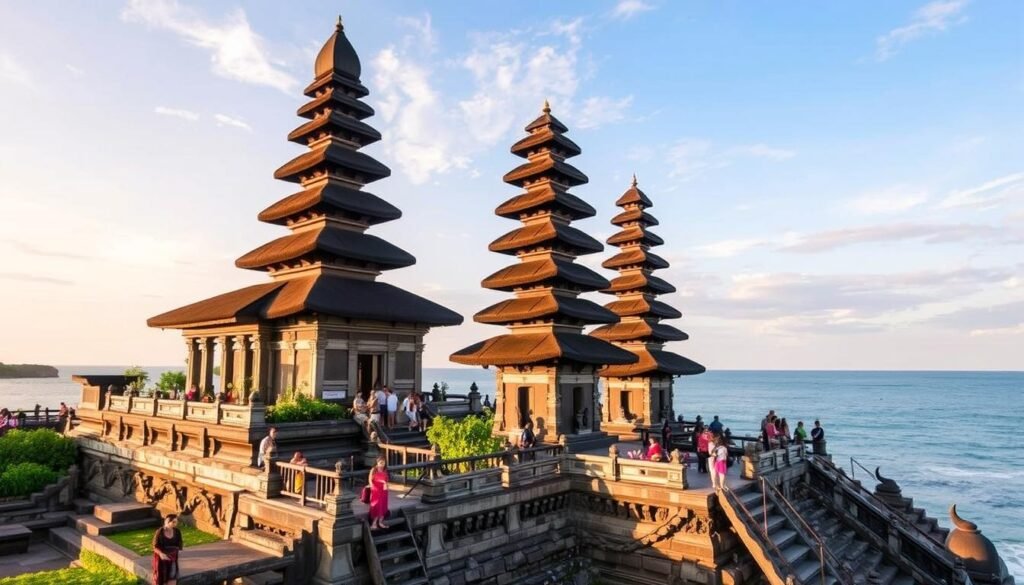
To get the most out of your Bali trip, consider these practical time-saving tips. Strategic planning can significantly enhance your Bali experience by minimizing time spent in traffic and queues.
Consider staying in different areas of the island for portions of your trip to reduce daily transportation time between attractions. Visiting popular spots like Tanah Lot and Uluwatu Temple during weekdays and early mornings can help you avoid crowds.
- Pre-book tickets for popular attractions online when possible to skip ticket queues upon arrival.
- Hire a knowledgeable local driver who can navigate efficient routes and suggest optimal visiting times for attractions.
- Group activities by geographic area to minimize travel time – for example, combine several Ubud attractions in a single day.
- Consider using ride-hailing apps like Grab or GoJek for shorter trips, often saving time compared to negotiating with local drivers.
- During peak season, make restaurant reservations several days in advance, particularly for popular sunset dining venues.
- Pack efficiently for changing weather conditions to avoid returning to your accommodation to change clothes mid-day.
By implementing these strategies, you can enjoy a more relaxed and fulfilling experience in Bali, making the most of your time on the island.
Conclusion
Bali’s charm is not limited to a specific time of year. With proper planning, you can enjoy this tropical paradise regardless of when you visit, experiencing unique moments in every season.

